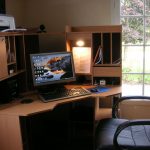Working from home has its perks, you can work with your cozy loungewear on, you never have to dread the morning commute, you have the freedom to set up your workspace the way you like to. More than likely, you have more control of the environment where you are working.
While it can be liberating to have a home office set up in your apartment, it can also come with challenges. Without the boss or your co-workers around, you can easily get distracted and tempted to put off a task especially if the bed is just a few steps away.
There are no rules in setting a workspace. Whereas one can work from a couch or bed, you want to make your work area a zone where you can get the most out of your productivity. Whether you are converting a whole room or carving out space in the corner of your place, creating a designated office can help you fight off lag time and ultimately boost your performance while completing your day-to-day tasks. Here’s what you should consider in setting up a small home office in an apartment.
1. Dedicate a space in your apartment
Segregation is key when it comes to working at home. With a little bit of creativity, there are plenty of spaces that can convert to an office. It doesn’t have to be big; tenants can renovate a room in an apartment or transform a nook that is infrequently used such as an empty closet, hallway, or a guest room. Ideally, make it semi-permanent, if you will work on a dining table, you have to remove it every time someone has to use the space. The last thing you want while working is being interrupted, that is why dedicating a work area is important.
Set up space, away from bed to visually separate work and leisure. Things that surround you while working influence your psychological state and the choices that you make. Make sure that your brain is not having a hard time focusing on the task just because you are getting distracted with the sight of your bed or wanting to watch on your television. It is important to choose an area where you feel comfortable with the view and where you feel you are settled and focused.
2. Choose proper furniture
Investing in a home office can be done in so many ways. The goal is to create an environment where you can be productive without compromising comfort. While it can be tempting to just grab any chair and desk that is available, if it is not designed for a long period of sitting, you might injure yourself and harm your posture.
As much as possible stick to an ergonomic chair and desk. Before making any purchase try searching first in your space if you have an upholstered chair with cushion and back support. As with the desk, choose the best height for your size while also considering the square footage of the space you are working with. Having the right equipment and setup helps you work at ease while maximizing productivity.
3. Consider having a nice background
If your work requires you to be on video, you don’t want your backdrop to be your bathroom or your open closet with your lingerie hanging freely. Not only does it look unprofessional on screen, chances of someone walking behind you on a towel are pretty much high. You don’t want to cause any trouble while in a meeting or presenting at work.
If you have limited space, consider adding a privacy divider in your home office setup. You can carve out a nook by using a standard divider or curtains so you can isolate your workspace.
4. Have a well-lit workspace
Set up your home office where you can get as much natural light as possible. Sitting in the same spot every day without proper lighting can deplete your creativity and productivity therefore you could benefit from a well-lit home office set-up.
If you are among the fortunate few who have a window near your desk, use a curtain to filter the amount of light coming in. If having natural light is a challenge, you can invest in the right kind of lamp. Just make sure it is indirectly placed on your monitor to avoid glare.
5. Account for storage
A home office should not be limited to a desk and a chair. Whether your workstation is carved out of a corner from your living room, it should also provide space for your files, stationery, and work essentials. Not to mention if you like to keep drinks and snacks while working, you have to account space for that too.
List down all the items you need daily so you have a clear idea of how much space to allocate for storage. It doesn’t have to be huge filing cabinets. A simple multi-level drawer could work to store all your stuff. An untapped wall is also a potential spot for a bookshelf or floating shelves to give you more storage without taking so much of the floor space.
6. Play with workspace decor
Part of having your workspace at home is getting an office space that you love. Do not be afraid to use your imagination to create a space that you feel productive and inspires you to do your work.
With such creative freedom, you can display decors that you find inspiring. Whiteboard mounted above your desk could not only serve as décor but will also help you organize your task and reminders at a glance. You could also place aesthetic wall calendars, your pen collections, or even a plant to add more warmth and life to your space.
About The Author:
Katreena is a scientist and a life hack specialist. She’s authored scientific journals on biotechnology and molecular biology. To take a break from scientific journals, she puts her mind into writing about lifestyle, health, and sustainability. She strongly believes that kindness makes the world go round.








